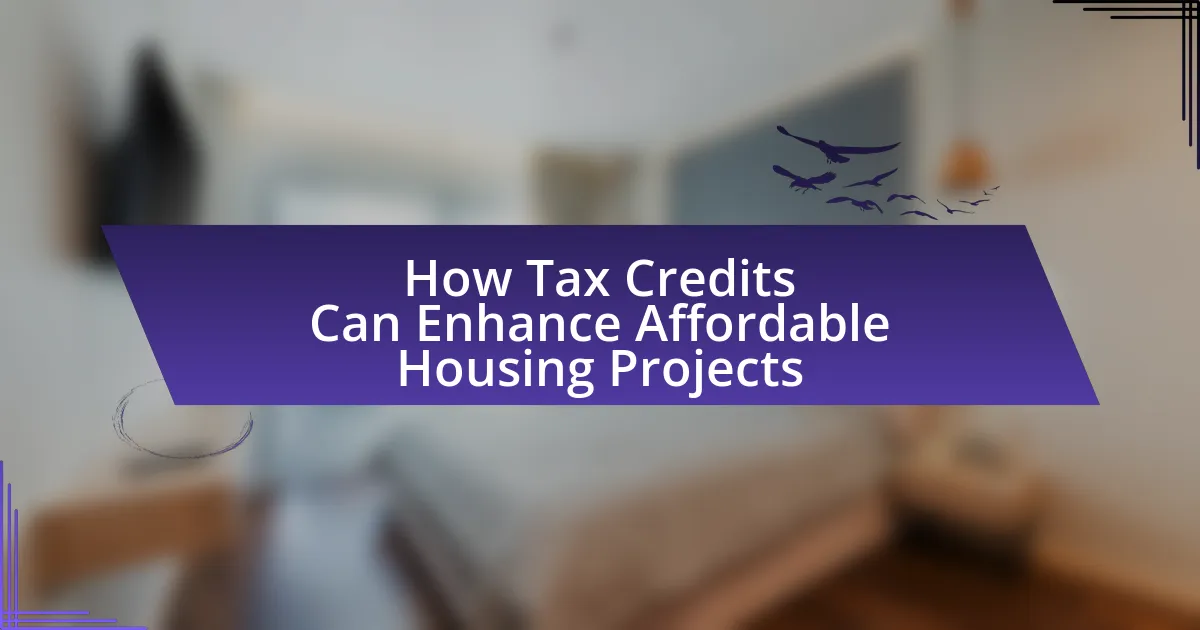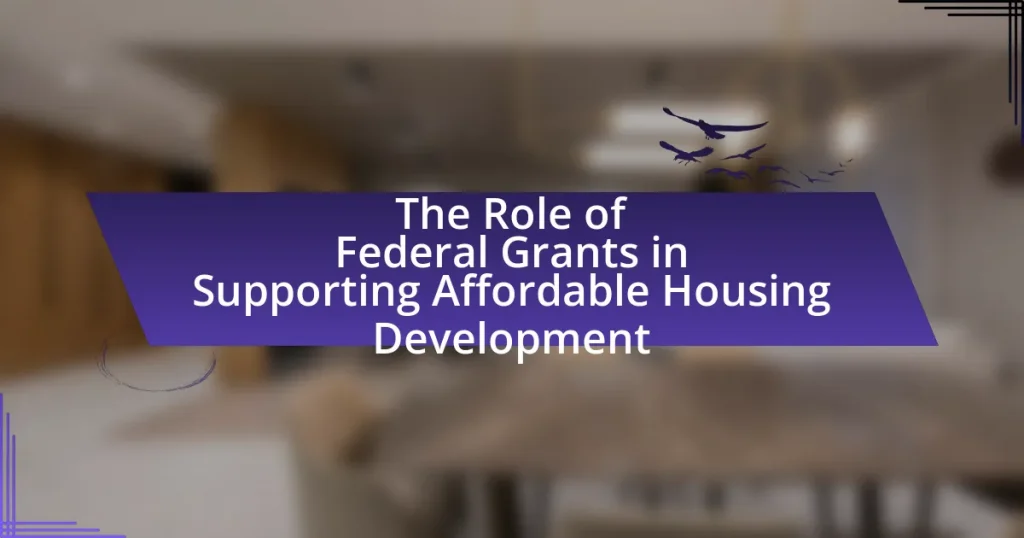Tax credits play a crucial role in enhancing affordable housing projects by providing financial incentives that lower development costs and attract private investment. Key programs such as the Low-Income Housing Tax Credit (LIHTC), New Markets Tax Credit (NMTC), and Historic Tax Credit (HTC) facilitate the construction and rehabilitation of affordable housing, significantly increasing supply and reducing rental prices for low-income families. The article explores how these tax credits work, their benefits, challenges faced by developers, and their long-term impact on communities, including neighborhood revitalization and economic growth. Additionally, it outlines best practices for developers to maximize the benefits of tax credits while navigating the application process effectively.

How do tax credits enhance affordable housing projects?
Tax credits enhance affordable housing projects by providing financial incentives that lower development costs and attract private investment. These credits, such as the Low-Income Housing Tax Credit (LIHTC), allow developers to reduce their tax liability, making it financially viable to build and maintain affordable housing units. According to the National Council of State Housing Agencies, the LIHTC program has financed over 3 million affordable housing units since its inception in 1986, demonstrating its effectiveness in increasing the supply of affordable housing.
What types of tax credits are available for affordable housing?
The types of tax credits available for affordable housing include the Low-Income Housing Tax Credit (LIHTC), the New Markets Tax Credit (NMTC), and the Historic Tax Credit (HTC). The LIHTC, established by the Tax Reform Act of 1986, incentivizes private investment in affordable rental housing by providing tax credits to developers based on the number of low-income units they create. The NMTC, created under the Community Renewal Tax Relief Act of 2000, encourages investment in low-income communities by offering tax credits to investors in qualified community development entities. The HTC, part of the Economic Recovery Tax Act of 1981, provides tax credits for the rehabilitation of historic buildings, which can also be used for affordable housing projects. These credits collectively aim to stimulate the development and preservation of affordable housing across the United States.
How do Low-Income Housing Tax Credits (LIHTC) work?
Low-Income Housing Tax Credits (LIHTC) provide tax incentives to private developers to create affordable rental housing for low-income individuals and families. The program, established by the Tax Reform Act of 1986, allocates tax credits to states based on their population, which then distribute these credits to developers who meet specific criteria. Developers can claim these credits over a 10-year period, significantly reducing their federal tax liability, which in turn helps to lower the cost of financing the construction or rehabilitation of affordable housing units. According to the National Council of State Housing Agencies, LIHTC has financed over 3 million affordable housing units since its inception, demonstrating its effectiveness in addressing housing shortages for low-income populations.
What are the benefits of Historic Tax Credits for housing projects?
Historic Tax Credits provide significant financial incentives for housing projects by allowing developers to receive a tax credit equal to a percentage of the rehabilitation costs incurred in restoring historic buildings. This financial support encourages the preservation of historic properties, which can lead to increased property values and revitalized neighborhoods. According to the National Park Service, every dollar of Historic Tax Credits generates approximately $1.20 in economic activity, demonstrating their effectiveness in stimulating local economies and creating jobs in construction and related sectors.
Why are tax credits important for affordable housing development?
Tax credits are crucial for affordable housing development because they provide financial incentives that lower the cost of construction and operation. These credits, such as the Low-Income Housing Tax Credit (LIHTC), enable developers to attract private investment, making it feasible to build and maintain affordable housing units. For instance, the LIHTC program has facilitated the creation of over 3 million affordable housing units since its inception in 1986, demonstrating its effectiveness in addressing housing shortages. By reducing the financial burden on developers, tax credits play a vital role in increasing the availability of affordable housing options for low-income families.
How do tax credits reduce the financial burden on developers?
Tax credits reduce the financial burden on developers by providing them with direct reductions in their tax liabilities, which effectively lowers the overall cost of their projects. For instance, the Low-Income Housing Tax Credit (LIHTC) allows developers to receive a dollar-for-dollar reduction in federal tax liability for a specified period, typically ten years, based on the amount invested in affordable housing. This financial incentive can significantly enhance cash flow, making it easier for developers to secure financing and invest in projects that might otherwise be economically unfeasible. According to the National Council of State Housing Agencies, the LIHTC program has financed over 3 million affordable housing units since its inception, demonstrating its effectiveness in alleviating financial pressures on developers.
What role do tax credits play in attracting investors?
Tax credits significantly enhance the attractiveness of investments by reducing the overall tax liability for investors. This financial incentive encourages capital allocation into projects, particularly in affordable housing, by improving the return on investment. For instance, the Low-Income Housing Tax Credit (LIHTC) program has facilitated the creation of over 3 million affordable housing units since its inception in 1986, demonstrating its effectiveness in drawing investor interest. By lowering the effective cost of investment, tax credits make projects more viable and appealing, ultimately leading to increased funding and development in the affordable housing sector.
What challenges do developers face when utilizing tax credits?
Developers face several challenges when utilizing tax credits, including complex application processes, stringent compliance requirements, and the need for extensive documentation. The complexity of tax credit programs, such as the Low-Income Housing Tax Credit (LIHTC), often requires developers to navigate intricate regulations and guidelines, which can be time-consuming and resource-intensive. Additionally, compliance with ongoing reporting and operational standards can strain project management and financial resources. For instance, a report by the National Council of State Housing Agencies highlights that nearly 30% of developers cite regulatory hurdles as a significant barrier to effectively leveraging tax credits for affordable housing projects.
How can bureaucratic processes hinder tax credit applications?
Bureaucratic processes can hinder tax credit applications by creating complex and lengthy procedures that applicants must navigate. These processes often involve multiple layers of approval, extensive documentation requirements, and strict compliance regulations, which can lead to delays and increased costs for applicants. For instance, a study by the National Council of State Housing Agencies found that inefficient processing times can extend application reviews by several months, discouraging potential applicants from pursuing tax credits. Additionally, the lack of clear guidelines and inconsistent interpretations of regulations among different agencies can further complicate the application process, resulting in confusion and potential rejections.
What are common misconceptions about tax credits in housing projects?
Common misconceptions about tax credits in housing projects include the belief that they are only available for low-income housing and that they are a form of direct cash payment. In reality, tax credits can be utilized for a variety of housing types, including mixed-income developments, and they provide a reduction in tax liability rather than direct funding. Additionally, some people think that tax credits are easy to obtain, but the application process is often complex and requires compliance with specific regulations and guidelines, such as those outlined by the Internal Revenue Service.

How do tax credits impact the affordability of housing?
Tax credits significantly enhance the affordability of housing by reducing the financial burden on developers and low-income renters. These credits incentivize the construction and rehabilitation of affordable housing units, making it economically viable for developers to invest in projects that serve lower-income populations. For instance, the Low-Income Housing Tax Credit (LIHTC) program has facilitated the creation of over 3 million affordable housing units since its inception in 1986, demonstrating its effectiveness in increasing housing supply and lowering costs for tenants. By lowering the overall development costs, tax credits enable developers to offer rents that are more aligned with the financial capabilities of low-income households, thereby improving access to affordable housing.
What is the relationship between tax credits and rental prices?
Tax credits directly influence rental prices by incentivizing developers to create affordable housing. When developers receive tax credits, such as the Low-Income Housing Tax Credit (LIHTC), they can lower their overall costs, which often leads to reduced rental prices for tenants. For instance, a study by the Urban Institute found that properties financed with LIHTC typically charge rents that are 20-30% lower than market rates, making housing more accessible to low-income families. This relationship demonstrates that tax credits serve as a financial tool to promote affordability in the rental market.
How do tax credits influence market rates for affordable housing?
Tax credits significantly lower the effective cost of developing affordable housing, which in turn influences market rates by increasing supply and stabilizing prices. When developers receive tax credits, they can afford to offer lower rents, making housing more accessible to low-income families. For instance, the Low-Income Housing Tax Credit (LIHTC) program has facilitated the construction of over 3 million affordable housing units since its inception in 1986, demonstrating a direct correlation between tax incentives and increased housing availability. This increase in supply helps to moderate market rates, as more affordable units enter the market, reducing competition for existing housing and ultimately leading to lower rental prices in the surrounding area.
What evidence exists to support the effectiveness of tax credits in reducing costs?
Tax credits effectively reduce costs in affordable housing projects, as evidenced by various studies and reports. For instance, the Low-Income Housing Tax Credit (LIHTC) program has been shown to stimulate the construction of over 3 million affordable housing units since its inception in 1986, according to the National Council of State Housing Agencies. Additionally, a study by the Urban Institute found that every dollar of tax credit generates approximately $1.20 in private investment, significantly lowering the overall financing costs for developers. These findings demonstrate that tax credits play a crucial role in making affordable housing financially viable.
How do tax credits affect the quality of affordable housing?
Tax credits significantly enhance the quality of affordable housing by providing financial incentives that encourage developers to invest in high-quality construction and maintenance. These credits, such as the Low-Income Housing Tax Credit (LIHTC), enable developers to reduce their tax liability, which can be reinvested into the properties to improve building standards, amenities, and overall living conditions. For instance, a study by the Urban Institute found that properties developed with LIHTC often have better maintenance and lower rates of physical deterioration compared to those without such financial support. This correlation indicates that tax credits not only stimulate the creation of affordable housing but also ensure that these units meet higher quality standards, benefiting residents and communities alike.
What improvements can be made to housing projects funded by tax credits?
Improvements to housing projects funded by tax credits can include enhanced design standards, increased energy efficiency, and better community integration. Enhanced design standards can lead to more livable spaces, as evidenced by studies showing that well-designed housing improves resident satisfaction and stability. Increasing energy efficiency through sustainable building practices can reduce long-term operating costs, with the U.S. Department of Energy reporting that energy-efficient homes can save up to 30% on utility bills. Better community integration, such as incorporating public transportation access and local amenities, can foster stronger community ties and improve overall quality of life, as highlighted by research from the Urban Institute indicating that mixed-income developments lead to better outcomes for low-income residents.
How do tax credits encourage sustainable building practices?
Tax credits encourage sustainable building practices by providing financial incentives that reduce the overall cost of implementing eco-friendly construction methods. These credits lower the tax burden for developers and builders who invest in energy-efficient technologies, renewable energy sources, and sustainable materials. For instance, the federal Investment Tax Credit (ITC) allows for a significant percentage of the cost of solar energy systems to be deducted from federal taxes, promoting the adoption of solar panels in new buildings. This financial support not only makes sustainable options more accessible but also drives innovation in green building practices, as developers seek to maximize their tax benefits while contributing to environmental sustainability.
What are the long-term effects of tax credits on communities?
The long-term effects of tax credits on communities include increased affordable housing availability, economic growth, and enhanced community stability. Tax credits, such as the Low-Income Housing Tax Credit (LIHTC), incentivize developers to invest in affordable housing projects, resulting in the construction of over 3 million affordable housing units since its inception in 1986. This increase in housing supply helps to alleviate housing shortages, particularly in urban areas, and contributes to the overall economic development of communities by creating jobs and increasing local tax revenues. Furthermore, stable housing conditions foster community engagement and reduce homelessness, leading to improved social outcomes.
How do tax credits contribute to neighborhood revitalization?
Tax credits contribute to neighborhood revitalization by incentivizing investment in underdeveloped areas, leading to improved infrastructure and increased property values. Specifically, programs like the Low-Income Housing Tax Credit (LIHTC) have facilitated the construction and rehabilitation of affordable housing, which in turn attracts businesses and enhances community services. For instance, a report from the National Council of State Housing Agencies indicates that every dollar of LIHTC investment generates approximately $1.20 in local economic activity, demonstrating the tangible benefits of tax credits in revitalizing neighborhoods.
What impact do tax credits have on local economies?
Tax credits significantly stimulate local economies by increasing investment in affordable housing and creating jobs. For instance, the Low-Income Housing Tax Credit (LIHTC) has facilitated the construction of over 3 million affordable housing units since its inception in 1986, generating approximately 1.5 million jobs annually. This influx of investment not only enhances housing availability but also boosts local businesses through increased demand for goods and services, thereby fostering economic growth. Additionally, tax credits can lead to higher property values and increased tax revenues for local governments, further contributing to community development.

What best practices should developers follow when applying for tax credits?
Developers should ensure thorough documentation and compliance with eligibility requirements when applying for tax credits. This includes maintaining accurate records of project costs, timelines, and compliance with local regulations. For instance, the Low-Income Housing Tax Credit program mandates that developers provide detailed financial statements and project plans to demonstrate eligibility. Additionally, engaging with tax credit consultants can enhance the application process, as they possess expertise in navigating complex tax regulations and maximizing potential credits. Following these best practices increases the likelihood of successful applications and ensures adherence to program guidelines.
How can developers effectively navigate the tax credit application process?
Developers can effectively navigate the tax credit application process by thoroughly understanding the specific requirements and guidelines of the tax credit program they are applying for. This includes familiarizing themselves with eligibility criteria, documentation needed, and deadlines. For instance, the Low-Income Housing Tax Credit (LIHTC) program requires developers to submit a detailed application that includes project plans, financial projections, and compliance with local housing regulations. Additionally, engaging with experienced consultants or legal advisors who specialize in tax credits can provide valuable insights and streamline the application process. Research indicates that projects with professional guidance have a higher success rate in securing tax credits, as they can better address complex regulatory requirements and avoid common pitfalls.
What documentation is essential for a successful application?
Essential documentation for a successful application in affordable housing projects includes a completed application form, financial statements, project plans, and proof of eligibility for tax credits. The application form provides necessary details about the project, while financial statements demonstrate the project’s viability and funding sources. Project plans outline the development’s scope, design, and timeline, ensuring compliance with regulations. Proof of eligibility for tax credits, such as income certifications and partnership agreements, is crucial for securing funding. These documents collectively establish the project’s legitimacy and financial feasibility, which are critical for approval by funding agencies and tax credit authorities.
How can developers build relationships with local housing authorities?
Developers can build relationships with local housing authorities by engaging in consistent communication and collaboration on housing projects. Establishing regular meetings to discuss project goals, community needs, and regulatory requirements fosters trust and transparency. Additionally, developers should actively participate in local housing forums and workshops, which provide opportunities to connect with housing authority representatives and understand their priorities. Evidence of successful partnerships can be seen in various affordable housing initiatives where developers who maintained open lines of communication with local authorities achieved smoother project approvals and better alignment with community objectives.
What strategies can maximize the benefits of tax credits in projects?
To maximize the benefits of tax credits in projects, particularly in affordable housing, developers should implement strategic planning, thorough financial analysis, and effective stakeholder engagement. Strategic planning involves identifying the most suitable tax credits available, such as the Low-Income Housing Tax Credit (LIHTC), which can significantly reduce project costs. A thorough financial analysis ensures that the project is structured to optimize tax credit utilization, including timing the application process to align with project milestones. Effective stakeholder engagement, including collaboration with local governments and community organizations, can enhance project visibility and support, leading to smoother approvals and potential additional funding sources. These strategies collectively ensure that projects not only qualify for tax credits but also maximize their financial impact, ultimately enhancing the viability and sustainability of affordable housing initiatives.
How can developers leverage partnerships to enhance project viability?
Developers can leverage partnerships to enhance project viability by collaborating with local governments, non-profits, and financial institutions to secure funding and resources. These partnerships can provide access to tax credits, grants, and other financial incentives that significantly reduce project costs. For instance, the Low-Income Housing Tax Credit (LIHTC) program has been instrumental in financing affordable housing projects, with over 3 million units created since its inception in 1986, demonstrating the effectiveness of such collaborations in increasing project feasibility and sustainability.
What role does community engagement play in successful tax credit projects?
Community engagement is crucial for the success of tax credit projects, particularly in affordable housing initiatives. Engaging the community fosters trust, ensures that the projects meet local needs, and encourages public support, which can lead to smoother project implementation. For instance, studies have shown that projects with strong community involvement often experience fewer delays and greater acceptance, as stakeholders feel their voices are heard and their concerns addressed. Additionally, community engagement can enhance the sustainability of these projects by creating a sense of ownership among residents, which is vital for long-term success.
What common pitfalls should developers avoid when utilizing tax credits?
Developers should avoid the common pitfalls of misunderstanding eligibility requirements, failing to document expenses properly, and neglecting compliance with program regulations when utilizing tax credits. Misunderstanding eligibility can lead to missed opportunities for funding, as specific criteria must be met to qualify for various tax credits. Proper documentation is crucial; without it, developers risk losing credits during audits or reviews, as evidenced by the IRS’s emphasis on maintaining accurate records for tax credit claims. Additionally, neglecting compliance with regulations can result in penalties or disqualification from future credits, highlighting the importance of adhering to the guidelines set forth by tax credit programs.
How can mismanagement of funds affect tax credit eligibility?
Mismanagement of funds can lead to ineligibility for tax credits by violating the financial compliance requirements set by tax credit programs. These programs, such as the Low-Income Housing Tax Credit, require strict adherence to budgetary guidelines and proper allocation of resources. If funds are mismanaged, it can result in financial audits revealing discrepancies, which may disqualify the project from receiving or continuing to receive tax credits. For instance, a study by the National Council of State Housing Agencies indicates that improper fund allocation can lead to a loss of up to 30% in potential tax credits for affordable housing projects.
What are the consequences of failing to meet compliance requirements?
Failing to meet compliance requirements can result in severe financial penalties and loss of funding. Organizations may face fines that can reach millions of dollars, depending on the severity of the non-compliance, as seen in cases where companies have been penalized for not adhering to federal regulations. Additionally, non-compliance can lead to the revocation of tax credits, which are crucial for affordable housing projects, ultimately jeopardizing their viability. For instance, the Internal Revenue Service has strict guidelines for tax credit eligibility, and failure to comply can result in disqualification from these programs, significantly impacting project financing and sustainability.



